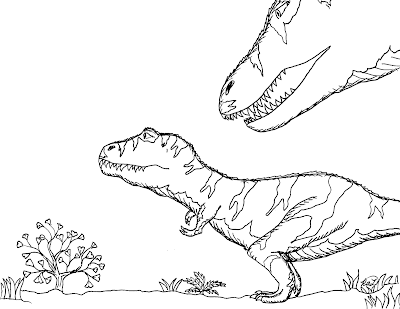T. rex Mommy at Hatching time
The Theropod dinosaurs, those like T. rex that ate meat, appear to have cared for their young. Fossilized Theropod eggs have been found in Portugal. The paleontologists did a cT X-ray on the eggs and the teeth were clearly sharp but tiny. These baby dinos would have required care for at least a few years. They were NOT able to take care of themselves. Robert Bakker, the famous paleontologist, says when he thinks of T. rex, he thinks of gentleness. Of course he means gentleness with their chicks. Young T. rex grew fast so they went from a few pounds or a few kilograms at birth to around 6-9 tons in about 18 years. So in the same time it takes a human to go from around 6 lbs. (3.6 kg) to up to around 200 lbs (91 kg). . . a T. rex goes from a few pounds to up to 9 tons. . . or 18,000 lbs. Notice that the adults in the drawings are very heavily built.
At age 14 T. rex juveniles had a growth spurt and they gained almost 5 lbs a day until they reached adulthood at around age 18. The paleontologists a a prominent university studied the growth rings in the fossilized bones of a bunch of T. rex specimens and that was their conclusion. They also think that most T. rex lived only til they were around 30 years old. So they had around 12 years of adulthood.
Other large Tyrannosaurs, (Albertosaurus I think) have been found that all died together. . . this indicates that they lived together. So we now think that T rex most likely lived in a pack. The young were cared for by older members of the group. . . like lions in a pride. Also, Tyrannosaurs in general probably hunted cooperatively in packs. The adults were so heavily built that they could not run very fast. But the somewhat recent discovery of sub-adult and juvenile Tyrannosaurs has led to the hypothesis that these large predators probably had the young chase the prey species, like duckbilled dinos, into ambushes where the large adults were waiting. Adult T. rex had the most powerful bite ever seen in the history of life on Earth. We know this from muscle attachment scars found on jaws and skulls of T. rex skeletons. The instinct to hunt is an inherited trait. Being able to hunt in a pack would be an acquired or learned trait. So the parents and the pack would have to take the juveniles out hunting to show them how it was done.
T. rex Mommy teaches her Young to Hunt
T. rex Baby and Parent closeup
T. rex baby in Nest
(Some paleontologists think that T. rex babies had feathers.)
Tyrannosaurus rex Mother in the Spring
(Mother crocodiles carry their babies in their mouth so this seems reasonable.)
T rex with Eggs
NOTE: We don't know what color T. rex scales were. But since modern reptiles, birds, and mammals can come with spots or stripes etc. I thought it made sense to draw various patterns.
T. rex hunts with Offspring
T. rex parent sneaking up on prey with adolescent
T. rex parent caring for chicks
T-rex mother and Pteranodon mother with Offspring
(If you want to color this for Mom for Mother's Day and you are a girl... just add eyelashes and the chick becomes a female. This is a trick in cartooning.)










No comments:
Post a Comment